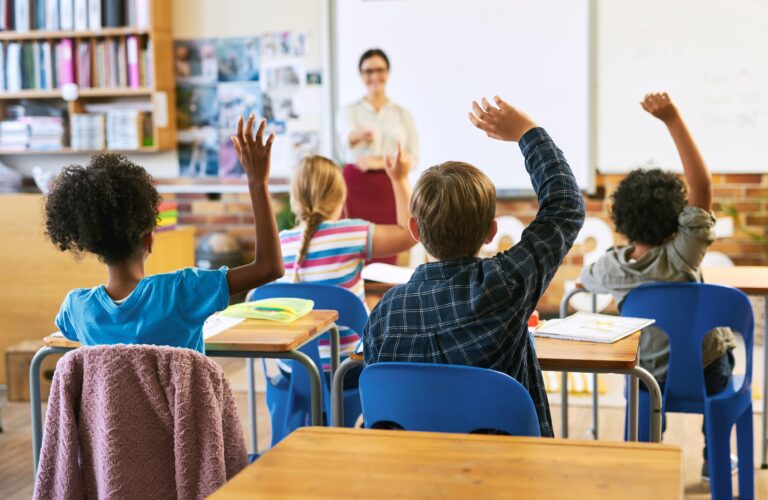Learners thrive in environments where there’s structure and familiarity, and implementing classroom routines provides students with a sense of predictability, where they feel safe and secure in the classroom. Studies have routinely shown that students learn better when they feel safe. However, this type of classroom climate doesn’t magically happen, it has to be cultivated through expectations, rules, and routines.
Routines provide a framework for structure and consistency and offer students a classroom environment where they can learn and thrive. Here we’ll take a closer look at why classroom routines are so vital, what types of routines are common in classrooms, as well as give you ideas on how you can establish a routine in your classroom.
Why Routines are Essential
Classroom routines are rituals or actions that are repeated time and time again. These routines that are repeated regularly provide students with a sense of security because they know what is expected of them. This predictable schedule makes it easy for students to navigate their learning environment. Additionally, it helps with time management by establishing a seamless flow and reducing disruptions during transitions when students are aware of the typical duration of an activity or task. The consistency of a routine can also reduce disruptive behavior because students know what is expected of them at all times of the day.
Routines teach important life skills such as responsibility and independence. Once students become familiar with the expectations of the procedure, they will take ownership of their responsibilities. Ultimately, students will spend more time learning instead of asking what they need to do next, all because a routine was set in place.
Types of Routines
Classroom routines don’t have to be limited to the beginning or end of the school day. They can be used for transitions, to get students’ attention, or in many other ways. Here are a few common ways classroom routines can be used throughout the day.
Entry and Exit Routine
Younger students can learn a procedure on how to enter and exit the classroom, while older students can learn what materials to grab to get started or how to put materials away before exiting the classroom.
Transition Routine
Students will move through transitions many times throughout the day. Learning a routine while moving from one activity or subject to another will make the transition smoother. Many teachers like to use signals or cues like a bell or timer to help the transition move along.
Student/Teacher Attention Routine
Establishing a routine to gain student’s attention or using a signal so students know how to get the teachers attention can prevent classroom disruptions or distractions.
Groupwork Routine
Establishing expectations and teaching students how to form groups will help to prevent classroom chaos. It also established clear expectations on communication, collaboration, and students overall learning experience while in the group.
Homework Routine
Providing a consistent method for submitting homework assignments and or reviewing homework assignments provides structure and contributes to improved academic performance. Not to mention that it will make everyone’s life much easier.
In addition to these routines, you can also have a routine for when students finish work early, how to collect and distribute materials, classroom jobs and responsibilities, using the bathroom, how to work independently, how to use classroom technology, or just about anything you can think of that you do daily and want it to go smoothly.
How to Establish a Routine
If you’re looking to establish and maintain a successful classroom routine, then consider following these steps.
Identify Your Goals
The first thing you want to do is think about how you want your classroom to function. Ask yourself what skills and habits you want your students to develop as well as what tasks and transitions you want to run smoothly. Once you decide upon your goals, this will help guide your choices for a predictable routine that you can set up and teach your students.
Choose Your Routines
You don’t have to choose a routine for every single goal you have in mind, but it also doesn’t hurt. The more routines you have implemented, the easier it will be for students to move about the classroom independently as well as limit the number of disruptions and distractions that are occurring.
Teach Your Routines
Next, it’s time to teach your routines. It’s wise to start with one or two each day because you don’t want to overwhelm your students. First, explain the reason for the routine, then go through each step of the procedure giving examples and non-examples of what it should look like.
Practice Your Routines
Give students plenty of opportunities to practice their routines. Consider hanging visual aids like posters, charts, or checklists in the classroom for students to reference.
Monitor the Routines
Once students have learned the routines, keep an eye on how they are working. If you notice they are not meeting your expectations, then revise or reteach them. You can also ask for assistance or suggestions from your colleagues or ask students how they think the routines are working or if there is anything they would change about the routine.
As you progress through the school year consider revisiting your classroom routines. Some routines may no longer be needed or just aren’t working like they used to. Or you may want to change some of the routines to give students more responsibilities. Remember, consistency is key when it comes to routines. Try and stick to each routine as closely as possible because predictability fosters a sense of security in students, and when they know what to expect each day it will make for a more productive and successful learning environment.




